
Tours and Itineraries
Our hotel, strategically positioned at the center of this cultural treasure, offers its guests unparalleled access to a wealth of historical and artistic experiences. Our commitment is to provide a stay that not only embraces luxury and comfort but also delves deeply into the depths of the history and art surrounding our property. We have prepared a selection of exciting excursions to ensure that your visit is filled with unforgettable experiences.
Historical Itineraries
Greek-Roman Naples
Our stroll begins at Maison des Fleurs, and we get to know the ancient origins of the city of Naples through a fascinating walk in its historic center: from the Greek walls of Piazza Bellini to Piazza San Gaetano, visiting the archaeological excavations of Neapolis Sotterrata in the church of San Lorenzo, and concluding the journey in the Cathedral with a visit to the ancient Basilica of Santa Restituta. If you wish to explore the settlements by the sea, the Municipio Metro station will transport you to a true Roman port with foundations of bastions and merchant ships. The archaeological park of Pausilypon and the Grotta di Seiano also represent evidence of Naples at its origins.
Angevin Naples
From Palazzo Carafa di Maddaloni, turning right through a stroll in the heart of Naples, with the churches of Santa Chiara and San Lorenzo, or in the area of the Naples port, with a visit to Castel Nuovo and the Church dell'Incoronata, the splendor of the Angevin court is evoked, retracing the history of the Kingdom of Naples.
Aragonese Naples
Exiting Maison des Fleurs, the Aragonese court and Renaissance culture take center stage in this stroll winding through the alleys and most important squares of the historic center of Naples: the churches of San Domenico Maggiore and Sant'Angelo a Nilo, the Pontano Chapel, and the 15th-century Neapolitan palaces serve as the backdrop to this fascinating Neapolitan history.
The Naples of the Viceroys: From the Counter-Reformation to the Baroque
100 years before the construction of Palazzo Carafa di Maddaloni, we find ourselves in the 16th century Naples. This century comes to life in the history of the most important monuments in Naples between Via Spaccanapoli and Via dei Tribunali: the Church of Gesù Nuovo and Santa Maria delle Anime del Purgatorio ad Arco, Via San Gregorio Armeno, and the complex of Pio Monte della Misericordia .
The grand Baroque decoration
Palazzo Carafa di Maddaloni is an example of the splendor and luxury of Neapolitan Baroque style. Just a few minutes on foot, and passing through the Church of San Gregorio Armeno and the Chapel of the Treasure of San Gennaro, we discover what art historians define as the 'Golden Century of Neapolitan Art,' namely the 17th century with its grand Baroque period.
The 18th century in the historic center of Naples
Restored and redesigned in the styles of the period, the arch of the portal of Palazzo Carafa di Maddaloni represents an initial encounter with the splendor of eighteenth-century pictorial art, featuring the magnificent fresco by Fedele Fischetti. Continuing, the splendor and extravagance of 18th-century art are explored through significant monuments such as the Sansevero Chapel, a treasury of art and secrets of the De Sangro family, the Cloister of Santa Chiara with its colorful majolica tiles, and Piazza del Gesù with the spire of the Immaculate.
Between the 1700s and the 1800s
Strolling along Via Toledo, the grand era of Naples as the capital of an autonomous kingdom comes to life through the testimonies of the past: from Piazza del Plebiscito to the Royal Palace, from Teatro San Carlo to Galleria Umberto I, we trace the milestones of the history of the Bourbon family and the events that characterized the history of Naples between the 1700s and 1800s.
The Twentieth Century
Neapolitan Art Nouveau begins with the Galleria Umberto I, strolling along Via Chiaia and Via dei Mille. In addition to being luxury shopping streets, we find buildings like Palazzo Mannajuolo and other constructions from that period. Finally, from the 20th century, Fascism and contemporary art take center stage in this itinerary. At Piazza Matteotti, we discover the rationalist architecture of the early 1900s, while on Via Toledo, with a visit to the Toledo and Montecalvario metro stations, we approach contemporary art and architecture. The itinerary concludes with a visit to the Hermann Nitsch Museum and Casa Morra.
In the bowels of Naples
Naples Underground (macellum and Greek and Roman walls), Napoli Sotterranea (approximately 40 meters deep), and the Bourbon Tunnel will reveal a Naples that extends beneath the surface, featuring naturalistic and historical sites, as well as guarding the mysteries of the city.
Pompeii and Herculaneum tour
with the public transportation service, you can reach Toledo Metro station in just a few minutes, and at the Central Station, take the Circumvesuviana train towards Sorrento. In 30 minutes, you will arrive at the Ercolano Scavi or Pompei Scavi stops.
If you prefer the Stress-Free option (cost starting from 120 euros), the staff will organize a private transfer from the Maison to Pompei and/or Ercolano and back.
Pietrarsa Museum
With its late 19th-century locomotives and the magnificent Royal Palace of Portici, they remain magical places to visit, a regional train departing from the nearby metro station that takes you directly to your destination.
Recreational Itineraries
The stairs of Naples
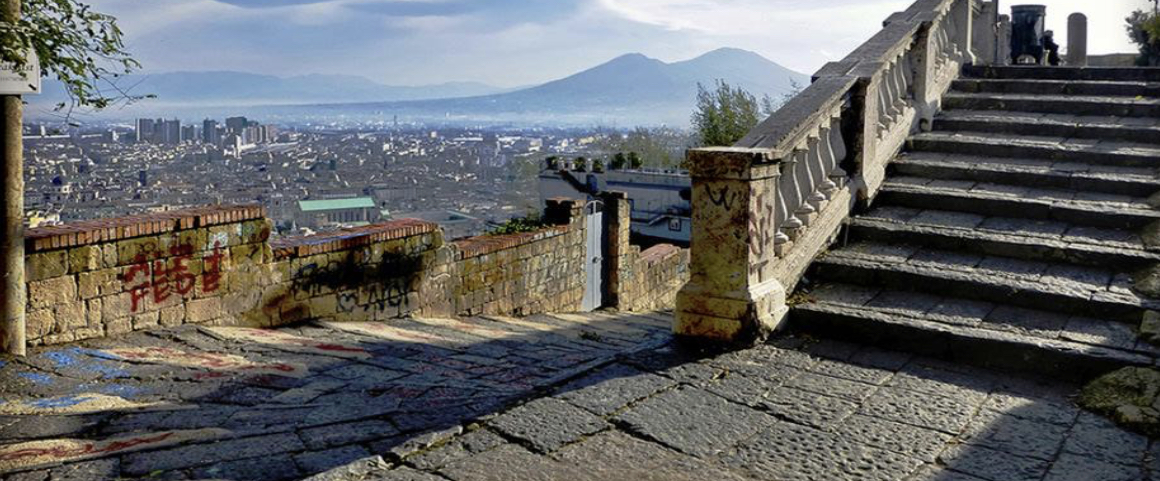 "The stairs of Naples" are ancient pedestrian pathways that connect different areas of the city, typically linking hilly neighborhoods with the city center and the waterfront. They are considered true urban artistic works, and despite the existence of faster and less strenuous means of transportation today, they are still used for their charm. They were built starting from the 16th century when the Spanish viceroy decided to expand the city beyond the Vomero hill, towards the "lower city," but over the centuries, similar pathways were also constructed in other neighborhoods. These staircases offer a beautiful way to explore the city and provide a different perspective, revealing always new corners and vistas. Many have disappeared, but dozens still exist, and among the most famous are the Salita della Pedamentina, the Rampe del Petraio, Calata San Francesco, Salita Moiariello, and the Stairs of Sant'Antonio ai Monti. For more information, you can refer to the section dedicated to the Stairs of Naples.
"The stairs of Naples" are ancient pedestrian pathways that connect different areas of the city, typically linking hilly neighborhoods with the city center and the waterfront. They are considered true urban artistic works, and despite the existence of faster and less strenuous means of transportation today, they are still used for their charm. They were built starting from the 16th century when the Spanish viceroy decided to expand the city beyond the Vomero hill, towards the "lower city," but over the centuries, similar pathways were also constructed in other neighborhoods. These staircases offer a beautiful way to explore the city and provide a different perspective, revealing always new corners and vistas. Many have disappeared, but dozens still exist, and among the most famous are the Salita della Pedamentina, the Rampe del Petraio, Calata San Francesco, Salita Moiariello, and the Stairs of Sant'Antonio ai Monti. For more information, you can refer to the section dedicated to the Stairs of Naples.
From Piazza Dante to Piazza del Plebiscito
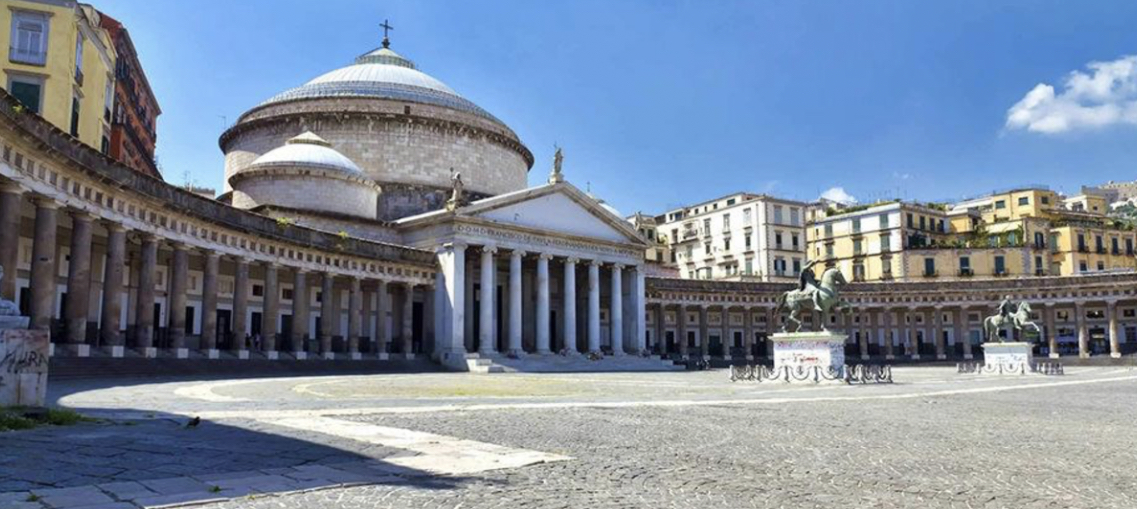 Piazza Dante is one of the most important squares in Naples, located in the historic center, and is characterized by the eponymous statue of the poet built in 1871. On one side stands the National Boarding School with 26 statues representing the virtues of Carlo di Borbone on top, and adjacent to it is Port'Alba, one of the ancient entrances to the city. Piazza Dante is at the beginning of Via Toledo, one of the completely pedestrian shopping streets. On this street, there are stores of major chains as well as local artisans, and it's worth stopping to visit the Toledo Art Station, considered one of the most beautiful in the world. Reaching the other end, after a mandatory stop at Esterina Sorbillo for fried pizza, you arrive at Piazza Trieste e Trento with the famous Caffè Gambrinus and, a short distance away, the San Carlo Theater. Immediately after is the enormous Piazza del Plebiscito, overlooking the Royal Palace and the Basilica of San Francesco di Paola.
Piazza Dante is one of the most important squares in Naples, located in the historic center, and is characterized by the eponymous statue of the poet built in 1871. On one side stands the National Boarding School with 26 statues representing the virtues of Carlo di Borbone on top, and adjacent to it is Port'Alba, one of the ancient entrances to the city. Piazza Dante is at the beginning of Via Toledo, one of the completely pedestrian shopping streets. On this street, there are stores of major chains as well as local artisans, and it's worth stopping to visit the Toledo Art Station, considered one of the most beautiful in the world. Reaching the other end, after a mandatory stop at Esterina Sorbillo for fried pizza, you arrive at Piazza Trieste e Trento with the famous Caffè Gambrinus and, a short distance away, the San Carlo Theater. Immediately after is the enormous Piazza del Plebiscito, overlooking the Royal Palace and the Basilica of San Francesco di Paola.
From via San Gregorio Armeno to Via Duomo
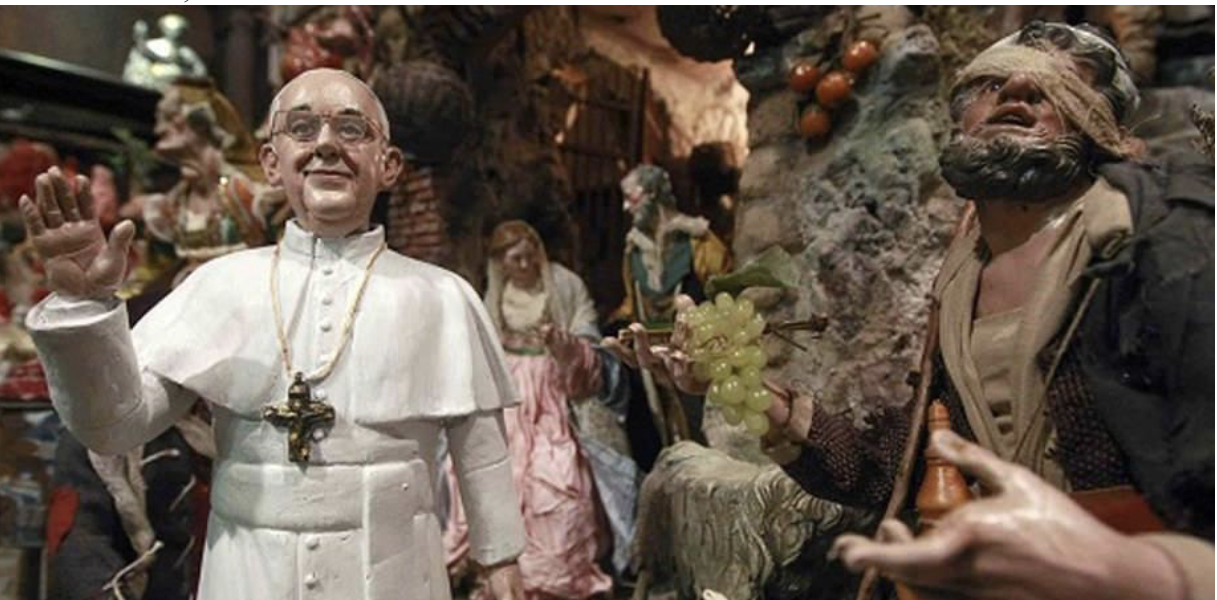 San Gregorio Armeno connects the Lower Decumanus with Via dei Tribunali and is known worldwide as the "Street of the Nativity Scenes." Dozens of artisan workshops display their creations throughout the year, featuring nativity scenes rooted in both tradition and contemporary themes. Along the street, you can stop at the Basilica of San Lorenzo Maggiore, from which you can access the ancient Roman market in the underground, while at the opening onto Via dei Tribunali, there is the monumental Basilica of San Paolo Maggiore, built on the remains of the Temple of the Dioscuri. Just to the side, there is the entrance to Naples Underground.
San Gregorio Armeno connects the Lower Decumanus with Via dei Tribunali and is known worldwide as the "Street of the Nativity Scenes." Dozens of artisan workshops display their creations throughout the year, featuring nativity scenes rooted in both tradition and contemporary themes. Along the street, you can stop at the Basilica of San Lorenzo Maggiore, from which you can access the ancient Roman market in the underground, while at the opening onto Via dei Tribunali, there is the monumental Basilica of San Paolo Maggiore, built on the remains of the Temple of the Dioscuri. Just to the side, there is the entrance to Naples Underground.
Via dei Tribunali is famous for hosting the city's best pizzerias, including renowned names like Sorbillo and Di Matteo. The street is also home to the Pio Monte della Misericordia with Caravaggio's "Seven Works of Mercy." At a certain point, the street intersects with Via Duomo, also known as the "Museum Street." In addition to the Cathedral, there are the Museum of the Treasure of San Gennaro, the Filangieri Museum, the Girolamini Complex, the Diocesan Museum, and the Madre Museum.
Via Benedetto Croce and Via San Biagio dei Librai
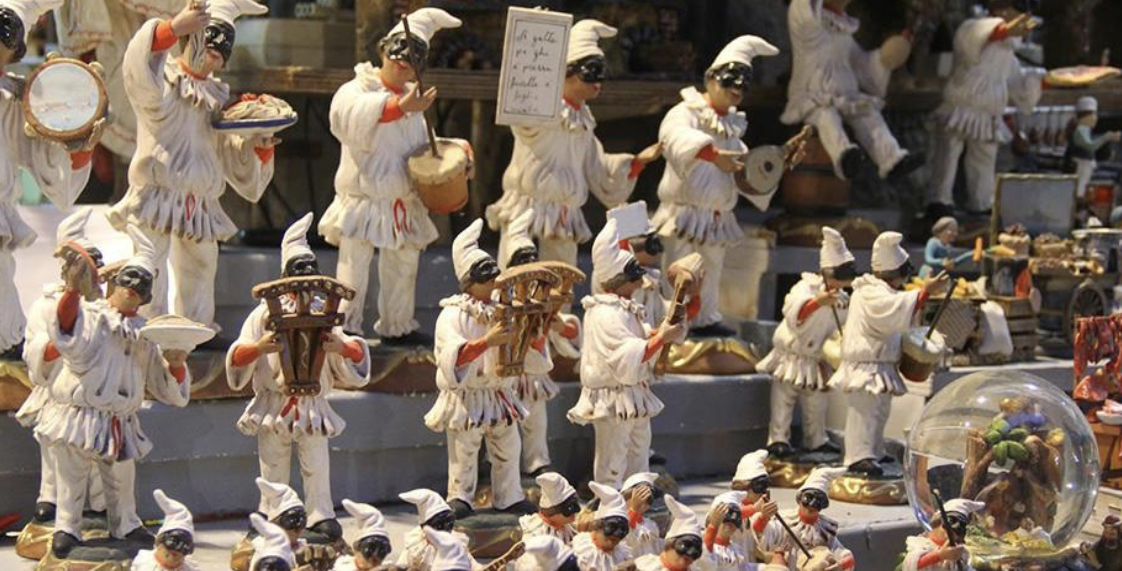 This stroll leads to the discovery of a part of the historic center where art and culture are breathed at every corner. Immediately after Piazza del Gesù, via Benedetto Croce begins, part of Spaccanapoli, where, in addition to many shops selling traditional Neapolitan items, bars, street food venues, and the famous artisanal chocolatier Gay Odin, stands Palazzo Venezia. So named because it was donated to the Republic of Venice in 1412, it can be visited on the first floor and is mainly used for events, evenings, concerts, and exhibitions.
This stroll leads to the discovery of a part of the historic center where art and culture are breathed at every corner. Immediately after Piazza del Gesù, via Benedetto Croce begins, part of Spaccanapoli, where, in addition to many shops selling traditional Neapolitan items, bars, street food venues, and the famous artisanal chocolatier Gay Odin, stands Palazzo Venezia. So named because it was donated to the Republic of Venice in 1412, it can be visited on the first floor and is mainly used for events, evenings, concerts, and exhibitions.
Continuing, you arrive at Piazza San Domenico Maggiore with the church of the same name and the obelisk, while a little further ahead is Largo Corpo di Napoli with the Statue of the God Nile, a testimony to the presence of an Egyptian community two thousand years ago. From here, via San Biagio dei Librai begins, that is, the Lower Decumanus, dotted with souvenir shops and craftsmanship, with Palazzo Carafa and Palazzo Marigliano towering over it, and where it is possible to visit the Monte di Pietà. About halfway through the route, you come across the famous San Gregorio Armeno.
From Via dei Mille to Via Chiaia
 Via dei Mille, Via Filangieri, and Via Chiaia are among the most frequented streets for those who wish to shop in high-fashion stores. The most famous ones are the large boutique of Louis Vuitton and the jewelry store of Bulgari, must-visit stops for high-quality purchases. Along Via dei Mille, you can also stop at PAN, the Palace of Arts in Naples, which hosts various exhibitions of contemporary and non-contemporary art by local and international artists, almost always with free admission.
Via dei Mille, Via Filangieri, and Via Chiaia are among the most frequented streets for those who wish to shop in high-fashion stores. The most famous ones are the large boutique of Louis Vuitton and the jewelry store of Bulgari, must-visit stops for high-quality purchases. Along Via dei Mille, you can also stop at PAN, the Palace of Arts in Naples, which hosts various exhibitions of contemporary and non-contemporary art by local and international artists, almost always with free admission.
Traveling along Via Filangieri, where you can stop at Prada, you reach Via Chiaia, a street teeming with clothing and shoe stores, but also with street food venues, bars, and ice cream parlors. Along the way, you'll find the Chiaia Bridge, built in 1636, which connects the area to the Pizzofalcone hill (but currently the elevator is out of order), while in a side street, there is the famous Pizzeria Brandi, where it is said that the Margherita pizza was born. At the end of the street, you emerge into the famous Piazza del Plebiscito.
Seafront and city park
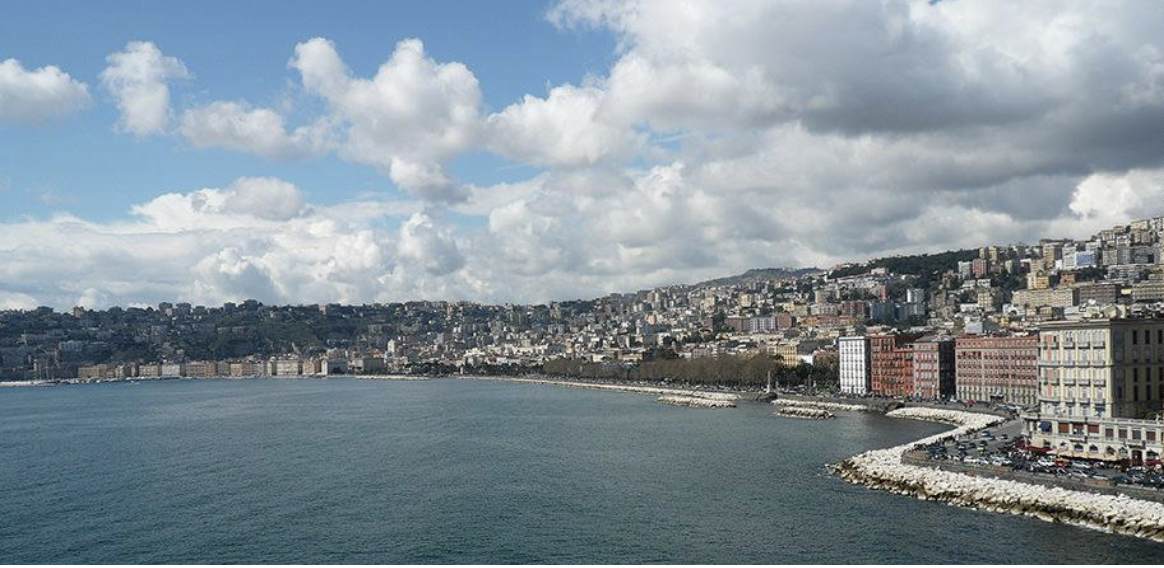 The one along the seafront is certainly one of the most fascinating walks in Naples, and many citizens and tourists consider it a must-visit in the city, also for the events that are often organized there. Stretching for about 3 km, it extends from Mergellina to Via Nazario Sauro, passing through the famous Via Caracciolo and the lively Via Partenope.
The one along the seafront is certainly one of the most fascinating walks in Naples, and many citizens and tourists consider it a must-visit in the city, also for the events that are often organized there. Stretching for about 3 km, it extends from Mergellina to Via Nazario Sauro, passing through the famous Via Caracciolo and the lively Via Partenope.
Luxury shopping
 San Pasquale a Chiaia area, surrounded by numerous alleys and small streets, is the snobbish part of the city. After visiting the church of the same name in the square, you can continue along Via Carlo Poerio, stopping in the many antique shops that display paintings, furniture, and even rare objects. Continuing, you reach Piazza dei Martiri, with the monument dedicated to the fallen of the Republic of 1799, where the Feltrinelli megastore is located. Instead, by venturing into the various alleys, you can stroll through Vico Belledonne, Via Cavallerizza, Via Bisignano, and Vico Alabardieri, rich in clothing and gift shops, wineries, and some bakeries, streets that make up the famous bar area. Via dei Mille, Via Filangieri, and Via Chiaia are among the most frequented streets for those who want to shop in high-fashion stores. The most famous ones are the large boutique of Louis Vuitton and the jewelry store of Bulgari, must-visit stops for purchases of international designer products. Along Via dei Mille, you can also stop at PAN, the Palace of Arts in Naples, which hosts various exhibitions of contemporary and non-contemporary art by local and international artists, almost always with free admission. Traveling along Via Filangieri, where you can stop at Prada, you reach Via Chiaia, a street teeming with clothing and shoe stores, but also with street food venues, bars, and ice cream parlors. Along the way, you'll find the Chiaia Bridge, built in 1636, which connects the area to the Pizzofalcone hill (but currently the elevator is out of order). At the end of the street, you emerge into the famous Piazza del Plebiscito.
San Pasquale a Chiaia area, surrounded by numerous alleys and small streets, is the snobbish part of the city. After visiting the church of the same name in the square, you can continue along Via Carlo Poerio, stopping in the many antique shops that display paintings, furniture, and even rare objects. Continuing, you reach Piazza dei Martiri, with the monument dedicated to the fallen of the Republic of 1799, where the Feltrinelli megastore is located. Instead, by venturing into the various alleys, you can stroll through Vico Belledonne, Via Cavallerizza, Via Bisignano, and Vico Alabardieri, rich in clothing and gift shops, wineries, and some bakeries, streets that make up the famous bar area. Via dei Mille, Via Filangieri, and Via Chiaia are among the most frequented streets for those who want to shop in high-fashion stores. The most famous ones are the large boutique of Louis Vuitton and the jewelry store of Bulgari, must-visit stops for purchases of international designer products. Along Via dei Mille, you can also stop at PAN, the Palace of Arts in Naples, which hosts various exhibitions of contemporary and non-contemporary art by local and international artists, almost always with free admission. Traveling along Via Filangieri, where you can stop at Prada, you reach Via Chiaia, a street teeming with clothing and shoe stores, but also with street food venues, bars, and ice cream parlors. Along the way, you'll find the Chiaia Bridge, built in 1636, which connects the area to the Pizzofalcone hill (but currently the elevator is out of order). At the end of the street, you emerge into the famous Piazza del Plebiscito.
The pearls of the Gulf of Naples
Capri, Ischia, and Procida are easily reachable. Molo Beverello is a stone's throw away from the Maison, and the Reception staff will be happy to provide you with information and assist you in purchasing tickets for hydrofoils and ferries.
If you wish, we will be delighted to organize sea excursions along the Neapolitan coastline, with stops at nearby islands, as well as along the Sorrentine Coast and the Amalfi Coast.

Boutique Hotel - Maison des Fleurs
Palazzo Carafa di Maddaloni
Via Maddaloni n. 6 - Historical Centre -
80134 Napoli
Tel./Whatsapp +393515620838
info@maisondesfleurs.net



